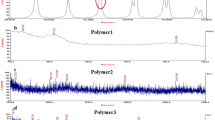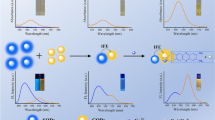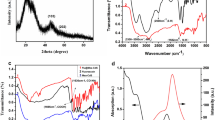Abstract
A fluorescent probe based on the functionalized carbon quantum dots (CQDs-OPD) was successfully synthesized for selective and sensitive detection of Cu2+. Using O-phenylenediamine (OPD) as the carbon resource and N,N-dimethylformamide (DMF) as the solvent, the CQDs-OPD was prepared by the hydrothermal method. The fluorescence mechanism of CQDs-OPD was studied by the intercept method. Furthermore, the probe was characterized by TEM, UV–Vis, FT-IR and Zeta potentiometric analysis, the fluorescent probe exhibits a good fluorescence properties and stability. The prepared ratio-fluorescent probe shows a good linear range from 0 to 25 μmol/L with a lower LOD of 40 nmol/L. Moreover, the probe also has been successfully applied to the detection of Cu2+ in the real samples with the recovery rate of 96.92–97.80% and the RSD of less than 2.0%.








Similar content being viewed by others
References
M. Giuffrida, T. Sfrazzettogiuseppe, C. Satriano, S. Zimbone, G. Tomaselli, A. Copani, E. Rizzarelli, A new ratiometric lysosomal copper(II) fluorescent probe to map a dynamic metallome in live cells. Inorg. Chem. 57(5), 2365–2368 (2018)
D. Zhu, Y. Luo, X. Yan, W. Xie, W. Cai, X. Zhong, A reaction-based fluorescent turn-on probe for Cu2+ in complete aqueous solution. RSC Adv. 6(90), 87110–87114 (2016)
S. Safty, M. Shenashen, M. Ismael, M. Khairy, M. Awual, Mesoporous aluminosilica sensors for the visual removal and detection of Pd(II) and Cu(II) ions. Micropor. Mesopor. Mater. 166, 195–205 (2013)
M. Awual, M. Hasan, M. Rahman, A. Asiri, Novel composite material for selective copper(II) detection and removal from aqueous media. J. Mol. Liq. 283, 772–780 (2019)
M. Ghaedi, M. Rezafathi, A. Shokrollahi, F. Shajarat, Highly selective and sensitive preconcentration of mercury ion and determination by cold vapor atomic absorption spectroscopy. Anal. Lett. 39(6), 1171–1185 (2006)
X. Jia, Y. Han, X. Liu, T. Duan, H. Chen, Speciation of mercury in water samples by dispersive liquid–liquid microextraction combined with high performance liquid chromatography-inductively coupled plasma mass spectrometry. Spectrochim. Acta B 66(1), 88–92 (2011)
Y. Feng, H. Chen, H. Chen, L. Tian, Sequential determination of tin, arsenic, bismuth and antimony in marine sediment material by inductively coupled plasma atomic emission spectrometry using a small concentric hydride generator and L-cysteine as prereductant. Fresenius J. Anal. Chem. 361, 155–157 (1998)
J. Zhang, M. Chen, C. Bai, R. Qiao, B. Wei, L. Zhang, R. Li, C. Qu, A coumarin-based fluorescent probe for ratiometric detection of Cu2+ and Its application in bioimaging. Front. Chem. 8, 800 (2020)
C. Shi, X.Y. Wei, F.J. Liu, Z.M. Zong, Carbon dots derived from facile tailoring of shaerhu lignite as a novel fluorescence sensor with high-selectivity and sensitivity for Cu2+ detection. ChemistrySelect 5(39), 12125–12130 (2020)
J. Yang, J. Chai, B. Yang, B. Liu, Achieving highly sensitive detection of Cu2+ based on AIE and FRET strategy in aqueous solution. Spectrochim. Acta A 211, 272–279 (2019)
C. Leong, W. Tong, W. Tan, N. Tumin, F.A.M. Yusof, L. Yacob, M.I.H.B. Rosli, T.M.D. Abu, Synthesis of curcumin quantum dots and their antimicrobial activity on necrotizing fasciitis causing bacteria. Mater. Today Pro. 31, 31–35 (2020)
Z. Wu, Z. Liu, Y. Yuan, Carbon dots: materials, synthesis, properties and approaches to long-wavelength and multicolor emission. J. Mater. Chem. B 5(21), 3794–3809 (2017)
Z. Wang, C. Xu, Y. Lu, X. Chen, H. Yuan, G. Wei, G. Ye, J. Chen, Fluorescence sensor array based on amino acid derived carbon dots for pattern-based detection of toxic metal ions. Sens. Actuators B Chem. 241, 1324–1330 (2017)
C. Li, W. Liu, Y. Ren, X. Sun, W. Pan, J. Wang, The selectivity of the carboxylate groups terminated carbon dots switched by buffer solutions for the detection of multi-metal ions. Sens. Actuators B Chem. 240, 941–948 (2017)
N. Chaudhary, P.K. Gupta, S. Eremin, P.R. Solanki, One-step green approach to synthesize highly fluorescent carbon quantum dots from banana juice for selective detection of copper ions. J. Environ. Chem. Eng. 8(3), 103720 (2020)
X. Wu, X. Gong, W. Dong, J. Ma, J. Chao, C. Li, L. Wang, C. Dong, A novel fluorescein-based colorimetric probe for Cu2+ detection. RSC Adv. 6(64), 59677–59683 (2016)
Q. Zhang, J. Sun, R. Zhang, X. Chen, N. Chen, F. Gao, Trichromatic-emission and dual-ratio semiconducting polymer dots as fluorescent probe for simultaneous quantification of Cu2+ and pH in vitro and in vivo. Chem. Commun. 56(61), 8647–8650 (2020)
S. Karami, M. Shamsipur, A. Barati, Intrinsic dual-emissive carbon dots for efficient ratiometric detection of Cu2+ and aspartic acid. Anal. Chim. Acta 1144, 26–33 (2021)
W. Zhang, N. Li, Q. Chang, Z. Chen, S. Hu, Making a cup of carbon dots for ratiometric and colorimetric fluorescent detection of Cu2+ ions. Colloids Surf. A 586, 124233 (2020)
R. Khattar, A. Yadav, P. Mathur, Copper(II) complexes as catalyst for the aerobic oxidation of O-phenylenediamine to 2,3-diaminophenazine. Spectrochim. Acta A 142, 375–381 (2015)
S. Liu, X. Qin, J. Tian, L. Wang, X. Sun, Photochemical preparation of fluorescent 2,3-diaminophenazine nanoparticles for sensitive and selective detection of Hg(II) ions. Sens. Actuat. B Chem. 171, 886–890 (2012)
D. Qu, M. Zheng, L. Zhang, H. Zhao, H. Fan, Z. Sun, Z. Xie, X. Jing, R.E. Haddad, H. Fan, Z. Sun, Formation mechanism and optimization of highly luminescent N-doped graphene quantum dots. Sci. Rep. 4, 5294 (2014)
D. Qu, M. Zheng, J. Li, Z. Xie, Z. Sun, Tailoring color emissions from N-doped graphene quantum dots for bioimaging applications. Light Sci. Appl. 4(12), 137–144 (2015)
T. Wang, A. Wang, R. Wang, Z. Liu, Y. Sun, G. Shan, Y. Chen, Y. Liu, Carbon dots with molecular fluorescence and their application as a “turn-off” fluorescent probe for ferricyanide detection. Sci. Rep. 9(1), 10723 (2019)
B. Liang, C. Jiang, Z. Chen, X. Zhang, H. Shi, Y. Cao, New iridium complex as high-efficiency red phosphorescent emitter in polymer light-emitting devices. J. Mater. Chem. 16, 1281–1286 (2006)
W. Liu, A. Li, C. Mak, K. Wong, Fabrication and electro-optic properties of ferroelectric nanocrystal/polymer composite films. J. Phys. Chem. C 112, 14202–14208 (2008)
H. Zhang, Y. Chen, M. Liang, L. Xu, S. Qi, H. Chen, X. Chen, Solid-phase synthesis of highly fluorescent nitrogen-doped carbon dots for sensitive and selective probing ferric ions in living cells. Anal. Chem. 86, 9846–9852 (2014)
Q. Li, D. Yang, Y. Yang, Spectrofluorimetric determination of Cr(VI) and Cr(III) by quenching effect of Cr(III) based on the Cu-CDs with peroxidase-mimicking activity. Spectrochim. Acta A 244, 118882 (2021)
J. Wang, J. Liang, X. Liu, H. Xiao, F. Dong, Y. Wang, X. Shu, F. Huang, H. Liu, Thiazoline-pyrene selective and sensitive fluorescence “turn-on” sensor for detection of Cu2+. Spectrochim. Acta A 215, 260–265 (2019)
Y. Yang, N. Xiao, Y. Cen, J. Chen, S. Liu, Y. Shi, Y. Fan, N. Li, H. Luo, Dual-emission ratiometric nanoprobe for visual detection of Cu(II) and intracellular fluorescence imaging. Spectrochim. Acta A 223, 117300 (2019)
Q. Jiang, Z. Wang, M. Li, J. Song, Y. Yang, X. Xu, H. Xu, S. Wang, A nopinone based multi-functional probe for colorimetric detection of Cu2+ and ratiometric detection of Ag+. Photochem. Photobiol. Sci. 19(1), 49–55 (2020)
D. Qian, Z. Wang, Z. Xiao, C. Fang, A fluorescent probe for the detection of Cu(II) in water and tumor cells. Inorg. Chem. Commun. 126, 108471 (2021)
Acknowledgements
This work was financially supported by the National Natural Science Foundation of China (Grant No. 32072297), Science and Technology Planning Social Development Project of Jiangsu Province (Grant No. BE2018694), Science and Technology Planning Modern Agriculture Project of Zhenjiang City (Grant No. NY2019014), Scientific Research Foundation of Jiangsu University (Grant No. Y19A010), the Fifth phase “169 Project” training fund of Zhenjiang and Jiangsu Collaborative Innovation Center of Technology and Material of Water Treatment.
Author information
Authors and Affiliations
Corresponding authors
Ethics declarations
Conflict of interest
We declare that we have no financial and personal relationships with other people or organizations that can inappropriately influence our work. There is no professional or other personal interest of any nature or kind in any product, service or company that could be construed as influencing presentation of the manuscript entitled.
Additional information
Publisher's Note
Springer Nature remains neutral with regard to jurisdictional claims in published maps and institutional affiliations.
Supplementary Information
Below is the link to the electronic supplementary material.
Rights and permissions
About this article
Cite this article
Yang, W., Wu, C., Wang, N. et al. Preparation of the Ratio-Fluorescence Probe Based on O-phenylenediamine for Selective and Sensitive Detection of Cu2+. J Inorg Organomet Polym 31, 4177–4187 (2021). https://doi.org/10.1007/s10904-021-02030-0
Received:
Accepted:
Published:
Issue Date:
DOI: https://doi.org/10.1007/s10904-021-02030-0




